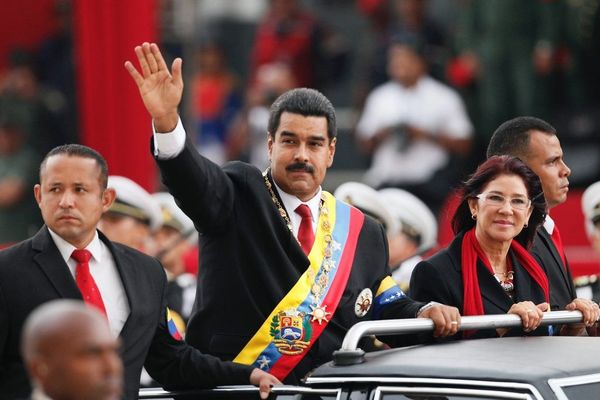OPINION / EXPERT PERSPECTIVE — After 9/11, the Directorate of Intelligence (DI) at CIA created a ‘Red Cell’ that was given the mission of truly thinking outside the box. It was staffed by a handful of the DI’s best analysts who were tasked to go beyond any reporting and think through hypothetical situations. The product was shared with the President and others, not as predictions, but as a way to stimulate their thinking about possible future developments. They were well received.
This is a Red Cell-like product. The situation: it is 2041 and China is now the pre-eminent global power having eclipsed the United States, and Beijing is busily re-ordering the international “rules of the game” established after WWII, to suit its needs.
The task for the Red Cell: explain how this happened.
The Tasking
Answer the question of what happened that enabled China to become the preeminent Global Power?
Politically, there was a successful transition from Xi to the current leadership, which has continued to press his vision, including closer ties to hardline regimes like Russia and Iran and the global south. This leadership is focused, has a clear vision of what it wants, and the resources and discipline to pursue its goal. While possessing the “advantages of a one-party dictatorship,” it has also managed the internal tensions and disadvantages of such a dictatorship.
Globally, China came to be seen as a more predictable partner and a source of development capital. It built lasting relationships—if not alliances—through its courtship of the global south, its Belt and Road initiative, its presence in organizations like BRICS (where it has assumed a leadership role), and the Shanghai Cooperation Organization.
It's not just for the President anymore. Are you getting your daily national security briefing? Subscriber+Members have exclusive access to the Open Source Collection Daily Brief, keeping you up to date on global events impacting national security. It pays to be a Subscriber+Member.
Early on, China also grasped the importance of narrative, and mastered it by the early 2030s, executing its cognitive warfare plan to shift the way the global community saw China. China used TikTok and other social media platforms to manipulate public opinion, improve the way citizens around the globe perceived its role in the world, and degrade views of the U.S. and the West. U.S. national security institutions did not recognize the threat until it was too late to counter.
Economically, the Chinese economy recovered from the problems of the mid-2020s and early 2030s and effectively managed the many challenges it faced: an aging population, environmental issues, and social tensions, including issues around the distribution of wealth, suppression of minority populations, and a closed political system. Western sanctions hurt at first but were ineffective in the end. Western businesses continued to eye the China market and entered into joint ventures that compromised their intellectual property. As first demonstrated in 2023 by the Charlotte Chip, China was able to leverage its domestic intellectual capital and gradually defeat Western efforts to deny it easy access to cutting-edge technology.
Indeed, Chinese R&D put it in the forefront of many key disciplines, and it was greatly aided in this effort by sending hundreds of thousands to students to study in the U.S. Over a 50-year period, U.S. academic institutions educated as many as 300,000 Chinese students a year largely in a myriad of science and technology fields, which Beijing used to establish and scale its industry. Students also established deep relationships with their American peers, and wide employment throughout American industry, financial, academic, and even government institutions. This ensured they were on the scene for cutting-edge developments. Aggressive IP theft by the Chinese government and government-funded hacker networks may have cost the U.S. some $6 trillion in economic output annually since then.
Subscriber+Members have a higher level of access to Cipher Brief Expert Perspectives and get exclusive access to The Dead Drop, the best national security gossip publication, if we do say so ourselves. Find out what you’re missing. Upgrade your access to Subscriber+ now.
Militarily, China continued throughout the 2020s and the 2030s, to invest heavily in its military, especially in force projection capabilities, its nuclear arsenal, and hypersonic weapons. Military R&D and the doctrine of Military-Civilian Fusion Development Strategy made these advances possible. It went to school on the Russia-Ukraine War and adjusted its doctrine and training while taking a hard look at the weaknesses in Russian equipment. It embraced hybrid warfare, merging cyber, economic, political, and soft power to build defense relationships that allowed it to position forces and logistics facilities at key transportation chokepoints around the globe.
The widely perceived rise in Chinese military capabilities and status as a global power led much of Asia to reorient its policies, distancing itself from the West without entering into a formal alliance or relationship with China. Asian leaders gradually came to give more weight to how Beijing would react to their initiatives than Washington. This was in part, a reaction to developments in the United States in the late 2020s and 2030s.
The period before China’s rise to preeminence was a difficult one for the United States.
Politically, the 2020s and 2030s were a period of weak political leadership with politics that tended to focus on what divided us rather than what we shared. There was an erosion of agreement on the core values of the founding fathers that made compromise harder. The decline in the effectiveness of Congress gave rise to an “imperial presidency” that governed increasingly through executive orders. Predictably, this led to large swings in policy as administrations changed, which made it harder for the business community to plan, invest, and innovate. For both friends and adversaries, it created the impression of division internally and a weakness of will. Sharp political divisions made it difficult to make hard decisions and resulted in many problems, foreign and domestic, being kicked down the road.
Globally, there was no clear strategic vision from the United States. Neo-isolationism and a general turning inward was common across the political spectrum. It is not surprising that allies came to see the United States as less reliable and less able to act internationally. Western allies also failed to live up to their international commitments, including those associated with NATO. Asian partners came to doubt the U.S.’s ability to play the role it had played for almost a century as guarantor of a peaceful Asian environment.
Economically, U.S. business struggled to make the investments needed to stay competitive, in part because of the political to-and-fro in Washington. The short view came to dominate planning, in part because the rules and guidance varied greatly from administration to administration making long-term planning and investment harder. Servicing the national debt also was a drag on the overall economy, and badly needed infrastructure and R&D projects suffered. The U.S. education system, once the best in the world, suffered. There was an erosion of standards and a reluctance to recognize and reward excellence.
Militarily, the United States saw a steady decline in the size and readiness of its armed forces. There are pockets of excellence, but the armed services suffered from difficulty in recruiting and retaining key personnel, especially as battlefield conditions came to be defined more and more by technology. R&D funding lagged and lead-times from Request for Proposal - to award - to actual product - grew. Personal services costs took up more and more of the defense budget, and equipment procurement suffered. On the intelligence side, there was greater reliance on technical collection and a reduced HUMINT capability, which in the past, had provided critical inputs to foreign policy and military decision makers. Indeed, the ratio of analysts and case officers to bureaucrats worsened across the community, and tooth-to-tail dollars suffered precisely as a more comprehensive understanding of the global environment was required. The U.S. did not make open source the information of first resort, causing us to miss key vulnerabilities and opportunities that China, Russia, and others, seized.
More broadly, China also effectively embedded itself into the fabric of U.S. culture. In the mid-2010s, Chinese nationals became the top foreign purchaser of U.S. residential property, often near sensitive government or technology facilities. Chinese firms also invested heavily in many key sectors of the U.S. economy, including technology, oil and gas, and entertainment and by the mid-2030s, it was difficult to separate—or decouple—our economies.
Bottomline, the rise of China and the decline of the United States was not a failure to recognize what was happening—the signs were clear from the early 2020s—but rather an inability to act.
The After-Action Report
This scenario is not inevitable, and it is purposely dark. There are a number of key variables that could produce a much different outcome, however. On the China side, much will hinge on a successful political transition from Xi to a like-minded leadership. China must also contain the social pressures and it must sustain its economic growth.
On the U.S. side, a return to a more civil dialogue would make it easier to find solutions for the issues we face. It would also reassure our allies and dissuade potential adversaries that we are “ripe for the picking” if they push.
A U.S. that is engaged globally, leads from the front, and has a strong military that can dominate a hybrid war environment, making for a more stable international environment and decreasing opportunities for China. U.S. business must maintain its long history of innovation and keep its economic rewards and as a society, we need to recognize and reward achievement.
The Cipher Brief is committed to publishing a range of perspectives on national security issues submitted by deeply experienced national security professionals. Opinions expressed are those of the author and do not represent the views or opinions of The Cipher Brief.
Have a perspective to share based on your experience in the national security field? Send it to Editor@thecipherbrief.com for publication consideration.
Read more expert-driven national security insights, perspective and analysis in The Cipher Brief















